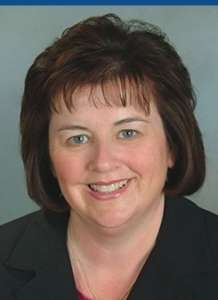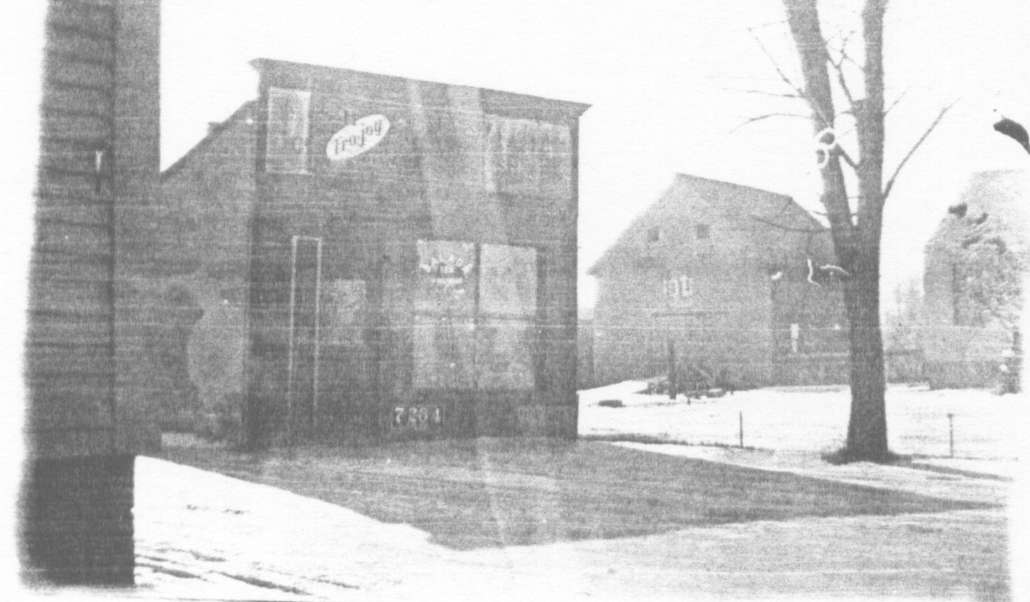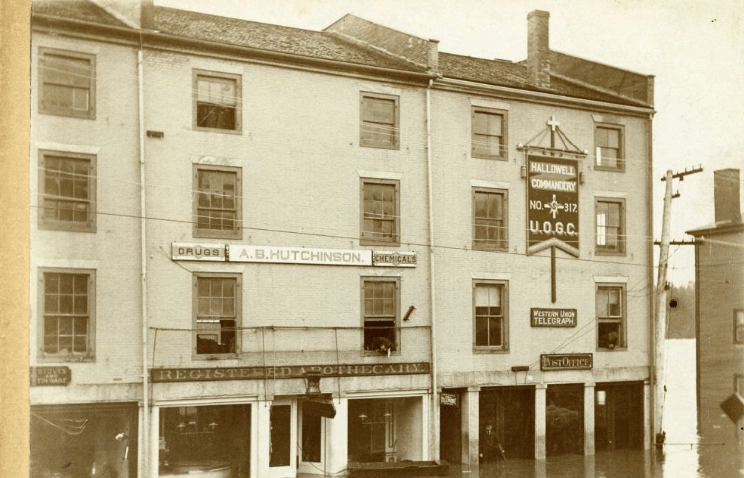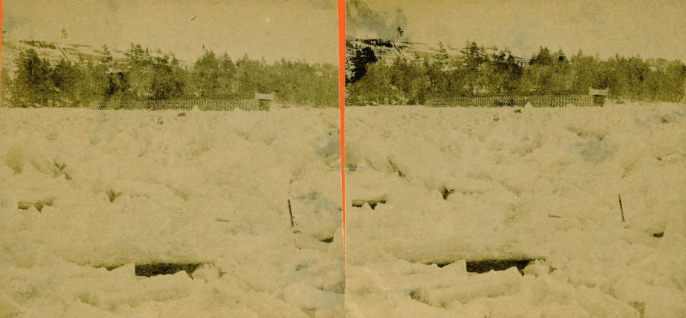Sarah Sachs named president of KFS Mortgage Company LLC
/0 Comments/in Business News, Community, Waterville/by Website EditorKFS Mortgage Company LLC, the Waterville-based lending corporation that is a wholly owned subsidiary of Kennebec Savings Bank, has named Sarah Sachs as its new president. Ms. Sachs brings extensive experience in residential mortgage, retail banking and small business lending to her new role.
Prior to joining KFS Mortgage Company LLC, Ms. Sachs served in key roles at other banks as a vice president and mortgage lending manager. Under her leadership, her teams have won local and national awards in residential lending and retail banking.
“I’m very excited to take on this new role,” Ms. Sachs said. “My mission is to expand our product offerings here at KFS Mortgage Company, hire mortgage officers, and open additional mortgage offices in other parts of the state.”
She noted that KFS Mortgage Company LLC offers government mortgage products through Freddie Mac, Maine Housing, Rural Development, and the VA that will enhance what Kennebec Savings Bank already offers.
An active member of the Central Maine community, Ms. Sachs currently serves as commissioner and treasurer of the Augusta Housing Authority; a member of the Board of Directors of the Augusta Teen Center, and president of the Board of Directors of Howell House. She is a member of the Maine Association of Mortgage Professionals and an affiliate member of the Kennebec Valley Board of Realtors and Greater Portland Board of Realtors. Ms. Sachs lives in Augusta with her husband, Alden. They have two grown children.
LIFE ON THE PLAINS: Remembering snow days in the ‘60s
/0 Comments/in Life on the Plains, Local History, Waterville/by Peter Cates by Roland D. Hallee
by Roland D. Hallee
The winter storm that blew through our area on Monday, and a story I read in the daily newspaper about eliminating snow days in lieu of remote learning, it reminded me of the days back in the 1950s and ‘60s when we would, on rare occasions, experience a snow day from school.
I have to preface this with explaining how things were done back then.
The Waterville Fire Station, which still stands at the head of downtown, was used for other things besides storing fire trucks. One of the routines was when the fire trucks were ready to leave the station, a horn would blow in a certain pattern. Let’s just say you would get two blasts, followed by three blasts, followed by one blast, people would go to the chart provided by the fire department, and the series of blasts would indicate where the fire was in the city.
Also, back in those days, every day, at 9 p.m., the fire horn would sound telling all children under a certain age – the exact age escapes me – would have to be off the streets and at home.
It would also be used to signal no school on storm days with three long blasts.
So, when the weather forecasters predicted a major storm, we would rise the following morning with the anticipation of hearing the fire horn, usually around 7 a.m. It didn’t happen often, but when it did, we all rejoiced – for a moment.
You see, we didn’t get the day off to sit in front of television, or play on our nonexistent, at the time, cell phones or other electronic devices. It was put on your flannel pants, flannel shirt, boots, and warm jacket, to go outside to shovel the driveway. As mentioned in the past, my dad didn’t believe in paying someone to plow when he had four strapping boys at home. Also, back then, no snow throwers.
Following the tedious work, which took several hours, considering our driveway was over 100 feet long, we would be allowed to do whatever was left to the day. It could mean going sledding, tobogganing, or for some of us, pick up a shovel and scourer the neighborhood in search of elderly folks who needed help shoveling, and maybe earn a couple of dollars along the way. Oh, yeah, there was also the backyard skating rink to shovel clear.
With most of the kids living within walking distance of school, we seldom had a snow day off if we had flurries or light snow, like what happens today.
I remember my grandfather saying – and he grew up in Canada – “I used to walk to and from school in bad weather, and it was uphill both ways.” A saying that is kind of worn out today.
So, as you can see, snow days off really weren’t days off.
Northern Light Inland Hospital receives national award
/0 Comments/in Community, News, Waterville/by Website Editor Recognized as a leader in the healthcare industry
Recognized as a leader in the healthcare industry
Northern Light Inland Hospital announced that it has been named a 2022 Human Experience (HX) Guardian of Excellence Award® winner for Clinical Quality by Press Ganey, a global leader in healthcare experience solutions and services. This award is part of Press Ganey’s annual ranking of the top hospitals and health systems in the country, according to performance in patient experience.
As a winner of the Press Ganey HX Guardian of Excellence Award®, Inland Hospital is in the top 5 percent of healthcare providers in the last year and is one of only seven hospitals nationwide to receive the clinical quality recognition. Twelve clinical measures from 2021 data were used to calculate the award including care from the emergency department, outpatient services, care related to pregnancy and related conditions, stroke, and blood clots. Press Ganey works with more than 41,000 healthcare facilities in its mission to reduce patient suffering and enhance caregiver resilience to improve the overall safety, quality, and experience of care.
“By putting their patients and workforce first each and every day, Inland Hospital is demonstrating their unwavering commitment to their employees and to the communities they serve,” said Patrick T. Ryan, chairman and chief executive officer, Press Ganey. “The caregivers at Inland have inspired us with the compassion, empathy and human connection they bring to the clinical healthcare setting. We are honored to partner with them as we celebrate their achievement.”
“We are excited to receive this recognition and very proud of everyone at Inland who goes above and beyond to deliver the highest quality of care possible,” said Nick Chobanian, MD, senior physician executive and vice president of Medical Affairs at Inland Hospital. “It takes a skilled clinical team dedicated to each patient and their individual needs, using excellent communication that engages patients and families in their care. Great teamwork helps us deliver the best medical outcomes.”
To learn more about Inland Hospital, visit northernlighthealth.org/Inland. Find more information on the award and Press Ganey at pressganey.com.
LIFE ON THE PLAINS: The cuisine on The Plains
/0 Comments/in Life on the Plains, Local History, Waterville/by Roland D. Hallee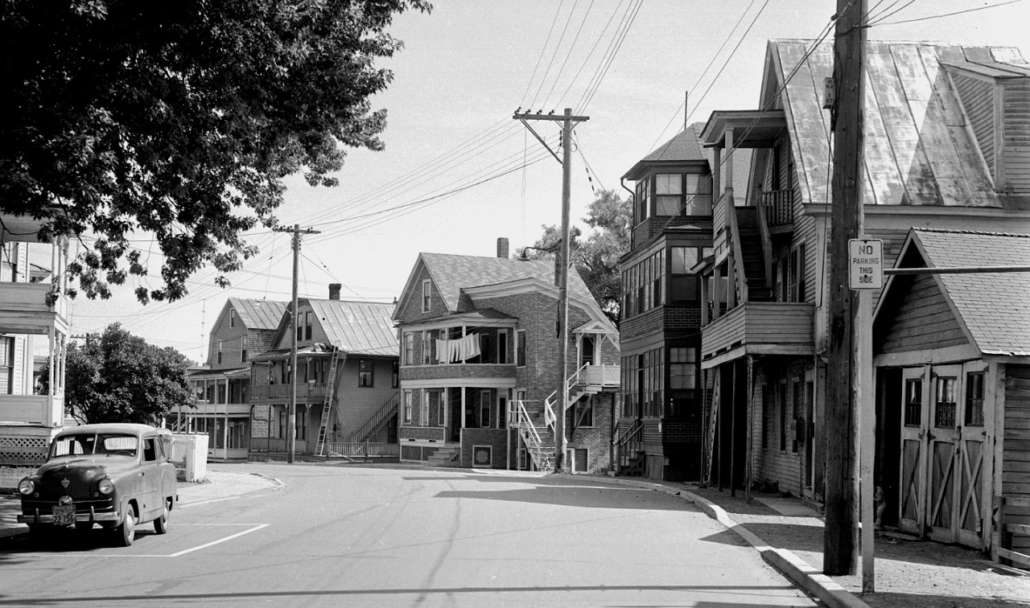
Water St. looking north. Notice the row of tenement buildings on the right. Those were built on the river bank, and were supported by stilts. They were removed in the 1960s and 1970s. (photo courtesy of
E. Roger Hallee)
 by Roland D. Hallee
by Roland D. Hallee
This week, I’ll let Peg Pellerin tell her story about the cuisine on The Plains.
Cuisine down on The Plains
by Peg Pellerin
I have found Roland Hallee’s articles about The Plains (La Plaine) in Waterville so interesting, especially since I grew up there from 1952 to 1972. His renderings have brought back so many memories and some of those memories involved the foods we ate.
Most residing in that area were mill working families. Since most of the laborers were the men of the families, the mothers did their best to make paychecks stretch, especially when it came to groceries and meals.
The majority of the people living in that part of town were of French Canadian descent, which meant French Canadian cuisine. I can still remember the aromas coming from the homes in the area, giving away what my friends were having for “souper” (pronounced soo-pey), the French terminology for supper.
A lot depended on what day it was even to what time of the year it was. The largest meal of the week was made on Sunday. What was left over was eaten during the week. I remeber my mother baking or boiling jambon (ham) (pronounced jean-bon) with carrots and potatoes. She would use the ham bone with some of the meat still on the bone and make “soupe aux pois” (pea soup). It was not a favorite of mine but I ate it because it was what my mother put in front of me. The choices of meals back then was take it or leave it, or go without. We never went without because we ate it.
Crèpes weren’t just eaten for breakfast. In fact it was more of a supper for my family than a morning meal. For those who aren’t familiar with this yummy food, it is a very thin pancake. We’d put loads of butter and
maple syrup on it. (Roland’s two cents: my mother would make them for breakfast. We’d put a line of brown sugar, roll them into a cigar-like shape, and put maple syrup on top.)
Another stretch of Sunday meal was taking leftovers of roasted chicken or turkey and making “ragout” (pronounced rag-goo). Some folks call it chicken and dumplings but it was mostly the poultry in a thick gravy with dumplings. We’d scoop it over mashed potatoes or bread.
Mom would make a roast of both beef and pork with potatoes and carrots. She’d purposely include more potatoes than she knew we’d eat because she intended to take the meat and grind it, then mash the potatoes and combine all with onions and place in a pie crust and, voila, tourtière. (Roland’s two cents: Our mother would grind the meat with the potatoes and onions and make a hash. I liked to put ketchup on mine.)
Most, including myself, usually make it around Christmas time, but mom made it often during the year. She would also take leftover pork and make creton, which is like having a pork paté, which was usually spread onto bread for a sandwich or spread over crackers.
Whatever my mother made, we’d never know that it was an inexpensive meal. It was a treat. Besides having beans and franks (Roland’s two cents: Don’t forget the pickled beets) on Saturday nights, which was primarily a Yankee tradition since the Civil War, (we also ate many non-French Canadian meals, too). Mom would cut potatoes in thick strips, fry them and pour gravy over it. Yup, that in itself was supper. Many now know it as “poutine”. We never had the curds put on it and to this day, I won’t eat it with curds. My most favorite inexpensive meal was “gallettes”, a/k/a fried dough. We would walk to Veteran Court, which was several streets away from ours and go to Bolduc’s Bakery, where anyone could go in to purchase baked bread or, in my mother’s case, uncooked dough. She’d fry pieces of it and while still warm pour maple syrup over it. YUMMY! (Roland’s two cents: One of our favorite desserts was a slice of bread dipped in molasses. Of course, mother’s “ice box cake”, for special occasions, was the best of all. Graham crackers which were placed standing, with a chocolate whipped cream filling between the crackers, then covered with the cream. Everyone fought for the end pieces because they were the best. It was to die for.)
I will end this article with a mouthwatering treat; at least it was for us back in the ‘50s and early ‘60s. “Tire d’erable”, a/k/a maple taffy, but mainly it is thick maple syrup poured over fresh clean snow. It’s difficult to find clean snow, even when it’s fresh. I guess if you want something similar, make snow cones and pour maple syrup over it. It’ll be good but not as good as we had “back in the day”.
Up and down the Kennebec Valley: Kennebec River floods – Part 2
/0 Comments/in Augusta, Hallowell, Local History, Maine History, Up and Down the Kennebec Valley, Waterville, Winslow/by Mary Growby Mary Grow
After the great freshet of 1832, with which last week’s article ended, Augusta business leaders went ahead with their plan to build a dam across the Kennebec River to power mills; and a Fairfield company dammed part of the river there.
The idea of an Augusta dam was by then about 50 years old. An early settler left a record predicting a dam in 1785, according to Augusta historian James North; and around 1818 Ephraim Ballard was quoted as saying he could build one for $25,000.
At the beginning of 1834, an Augusta group petitioned the Maine legislature to form a corporation to build a dam. Despite opponents’ concerns about effects on fishing, river transportation and upriver communities that might be flooded, a legislative majority created the Kennebec Dam Company in March 1834.
Work started in the spring of 1836. Expanded plans and time constraints meant the middle of the dam was left open through the winter of 1836-37; the ends survived freshets in November and December 1836 and April 1837.
In March 1837 the legislature renamed the dam company the Kennebec Locks and Canals Company and doubled the amount of capital stock it could issue, to $600,000. Work resumed in June; the 600-foot-long dam was closed Sept. 27; and the lock that allowed boats to pass opened Oct. 12, in a ceremony that was followed by a celebratory dinner.
In Fairfield, according to the Fairfield Historical Society’s bicentennial history, sometime between 1835 and 1840 the Fairfield Land and Mill Association dammed the west channel of the Kennebec between downtown Fairfield (then Kendall’s Mills) and Mill Island. “This earthen and timber dam had a short life as an [undated] unusual surge of high water washed it away.”
Its (undated) replacement a short distance downriver “was ingeniously unique in having a hinged bulkhead at its downstream end that swung open to release the pressure when the flow of water became excessive at flood stage.”
North described the solidity of the 1837 Augusta dam in detail, with illustrations, talking about ballasted timber cribs, thick planks, granite walls, cement, cast iron and iron strapping and similar substantial materials. The project used 800,000 cubic feet of granite, 2.5 million feet of timber and 25 tons of iron, and cost the full $300,000, he wrote.
The river continued to flow through a canal along each bank. North’s sketch shows the lock on the east end, between the dam and the canal.
A May 1838 freshet brought high water and giant logs that damaged the west bank, and a January 1839 windy rainstorm damaged it again (and covered Hallowell’s Water Street four feet deep in icy water). Nonetheless, Locks and Canals Company directors promptly started seeking proposals to build mills to use the water power, and by late May 1839 ten mills were almost built.
Then came, North wrote, “one of those catastrophes which mock at human foresight and defy human energy to resist.” After several days of rain, about 4 a.m. Friday, May 30, water began to go over the west side canal and through the damaged bank.
People “assembled in great numbers” to try to repair the leaks, but when the canal itself began to give way, they fled. The dam held; the river made a new channel about 500 feet wide around the west end, taking out two houses in the process (one, North said, was about a tenth of a mile from and 100 feet above the former shore).
An effort to blow up the mills to prevent their doing damage downstream failed, and one by one they were lifted off the dam, the last one floating away late Saturday afternoon.
Thus ended the first attempt to use the Kennebec to power Augusta industries. The dam stood blocking the river; the new channel was unnavigable; and during the summer of 1839 merchandise had to be unloaded from one boat and carried to another on the other side of the dam, “which was frequently piled high with various descriptions of goods in the process of transit.”
Businesspeople were annoyed. The company corporators had lost their investment. The legislature in March 1840 repealed the company charter effective Aug. 1, unless by then the corporators promised a rebuilt dam within two years.
North credited General Alfred Redington with saving the situation. Redington said if he were given a mill site, water power, “the materials of the old mills swept away in 1839” and as much money as people could come up with, he would build an improved dam and put a sawmill atop it.
The dam was to be 400 feet long, “upon a ledge, in shallow water, and not so high as the old dam” and Redington thought he could do it for $10,000.
Beginning with an Aug 1, 1840, public meeting, he did it. North wrote that work started Sept. 5, 1840, and was apparently finished promptly. Redington’s mill went up “during the following winter” (1840, or 1841?).
(Although both North and Henry Kingsbury, in his chapter on manufacturing in his Kennebec County history, referred to “rebuilding” the dam, what they described as actually built was a 400-foot addition to the 600-foot dam, extending it across the new channel the river had carved on the west end.)
Another sawmill opened on the east end of the (original?) dam, and a machine shop, in 1842. In 1845 and 1846 there was a burst of expansion: cotton mills, a flour mill and half a dozen sawmills.
Kennebec floods tried the rebuilt dam repeatedly. On April 28, 1843, a “southeasterly storm” raised the river to within four feet of the 1832 level. Four and a half days of rain that began Friday evening, Oct. 31, 1845, brought more than four inches of water. Logs, lumber and remains of upriver buildings were carried on “a magnificent sheet [of water] of great depth” over the dam.
The dam was undamaged both times. North gave credit to the width of the “wasteway,” almost the entire width of the dam, and the way the road bridge just downstream narrowed the waterway to 440 feet, divided by the central bridge pier.
The result, he explained, was the water level below the dam rose faster than the level above it and the force diminished. Normally, the water below the dam would be about 15 feet lower than in the pond behind it; during the 1845 freshet the difference was reduced to five feet.
This flood damaged two Augusta wharves and swept away the basement framing for a new block of six sawmills.
The river breached the new dam at the end of March 1846, when several days of rain following a normal spring rise as snow melted brought down “floating ice…intermixed with logs.”
The rebuilding had left a stone pier (the west end of the original dam, 400 feet from the west shore) as a connector between old and new sections “rising like a tower unprotected above the top of the dam.” An ice cake knocked it down, and in following days the adjoining area washed away; by Saturday, April 11, 1846, there was a 150-foot opening.
Repair work started Monday, April 13, North wrote, and despite a couple more freshets was finished “in about ten weeks,” for about $13,000.
The next damage was from fire, not water: in September 1853 most of the industrial buildings on top of the dam burned. The dam was quickly “repaired, improved and strengthened.”
In June 1855, part of the 1846 repairs failed. About 100 feet of the dam were swept away; repairs cost about $20,000.
North wrote these repairs were tested by a major flood before the derricks used in the work had been taken away. An estimated five inches of rainfall between Friday evening, Oct. 12, and late Saturday, Oct. 13, raised the river level 21 feet by Sunday afternoon, “within eighteen inches of the highest point of the great freshet of 1832.”
The dam was unscathed.
The next major floods North described occurred in October 1869 and January and February 1870. The southeaster that began pouring rain on the Kennebec Valley Sunday morning, Oct. 3, 1869, was expected to be fairly harmless, because the river was low at the time; but it did major damage from Skowhegan south (and through much of New England).
Logs that lumber companies had harvested over the summer and left floating were carried downriver to create jams, notably one at Hallowell, that raised the water behind them. At Waterville, the Ticonic toll bridge was torn from the banks and floated downriver.
(This bridge, Edwin Whittemore wrote in his Waterville centennial history, dated from 1835. It had been damaged in the 1855 flood and quickly repaired. After it washed out in October 1869, a new free bridge was built for $32,000, mostly paid by Waterville taxpayers; it opened Dec. 1, 1870.)
North wrote that to prevent the Ticonic bridge taking out Augusta’s railroad bridge, “A locomotive was despatched with ropes and a crew of men, who met it in Vassalborough and fastened it to the shore.” The part that came loose and went over the dam was not solid enough to do damage.
This October 1869 freshet damaged warehouses on Augusta wharves and swept away piles of logs and lumber.
The following months, North wrote, were “generally mild,” but with occasional cold spells that froze the river to a considerable depth. After Christmas came another warm spell “which started the buds on trees in favorable exposures” and was followed by rain on Jan. 3, 1870.
The rain caused a freshet; the freshet broke up the ice over rapids in the Vassalboro area; the ice came down and jammed above unbroken ice in Augusta, Hallowell and Gardiner. In Hallowell and Gardiner, North wrote, water started backing up during the night; town officials had bells rung to notify Water Street business owners to rescue merchandise from their basements.
A cold spell added more ice to the jams. From Feb. 18 through 20, 1870, rain and wind moved more ice downstream, until, North wrote, the river was one continuous thickly-layered jam from near the Kennebec Arsenal (on the east bank a bit downriver from old Fort Western) to Hallowell. In places the ice-layers were 15 feet thick; in places they rested on the river bed.
This barrier made the river rise six feet in 30 minutes, until the water levels were equal above and below the Augusta dam. “The dam was completely flowed out, a slight ripple only marking its place,” North wrote.
He described in detail – probably from personal observation – 175 feet of the wooden railroad bridge (built in 1857, according to Charles Nash’s chapter in Kingsbury’s history) breaking away, turning upside down from the weight of the track on top and floating toward the already damaged road bridge, “a huge battering ram.”
When the upside-down floating bridge crashed into the stationary one, one end dipped under and came up on the downriver side, leaving 20-foot-long “legs” sticking up on either side. The mass wriggled until it bounced out and continued downriver, to the “joyous shouts and cheers of many anxious spectators.”
Nash wrote that 160 feet of the Augusta dam went down the river, and commented this was the fourth major damage since 1837. The dam was rebuilt “in a more elaborate and expensive manner than ever before” by the end of 1870; the road bridge was repaired; and a new iron railroad bridge was built “immediately.”
In Hallowell, North wrote, the bridge was carried away and some stores were moved from the east (river) side of Water Street to the west side. An on-line source estimated damage at more than $1 million, including loss of two bridges (road and railroad) and walls torn off buildings by the ice.
This 1870 freshet, North wrote as he concluded his history of Augusta, was the fiercest yet; the water level was two feet higher than in 1832.
Main sources
Fairfield Historical Society Fairfield, Maine 1788-1988 (1988).
Kingsbury, Henry D., ed., Illustrated History of Kennebec County Maine 1625-1892 (1892).
North, James W., The History of Augusta (1870).
Whittemore, Rev. Edwin Carey, Centennial History of Waterville 1802-1902 (1902).
Websites, miscellaneous.
Rotary Club wraps up successful auction
/0 Comments/in Community, Waterville/by Website Editor The 59th annual Waterville Rotary Auction with hundreds of gifts, services and discount items wrapped up the first week of December. Every year, for more than half a century, this important community event has supported Rotary’s efforts to make a difference in the community. Proceeds from the auction will again go to support community programs and initiatives in early childhood development and education, helping to ensure a bright future for our community’s most vulnerable and valuable asset, our children.
The 59th annual Waterville Rotary Auction with hundreds of gifts, services and discount items wrapped up the first week of December. Every year, for more than half a century, this important community event has supported Rotary’s efforts to make a difference in the community. Proceeds from the auction will again go to support community programs and initiatives in early childhood development and education, helping to ensure a bright future for our community’s most vulnerable and valuable asset, our children.
This year, Rotary Club of Waterville identified the construction of the new Children’s Discovery Museum and the development of a second natural play area at Educare Central Maine as recipients of auction proceeds. Both of these amazing organizations located in Waterville make a difference for the children served, with programs focused around childhood literacy and development.
Rotary Club of Waterville thanks the community for its support and contribution to area businesses and to the promotion of literacy in central Maine and beyond. Your participation generated nearly 240 items donated to the auction, resulting in net proceeds over $18,000.
Special thanks are extended to the auction committee, Mix 107.9 for live coverage and interviews during the auction, Central Maine Motors Auto Group, the Mid-Maine Chamber, and fellow Rotarians for assistance in this undertaking.
For more information about the Rotary, visit the website at http://www.watervillerotary.com.
Big Brothers, Big Sisters needed for 100 waiting Littles
/0 Comments/in Central ME, Community, Kennebec County, Waterville/by Website Editor
Little Sister Ryder Perkins meets with her Big Sister Hayley SooHoo once a week to chat while they draw, color, takes walks, and sometimes even learn new dances together. Their friendship was created through Big Brothers Big Sisters of Mid-Maine’s longstanding, one-to-one mentoring program that matches children facing adversity with positive role models. (contributed photo)
by Monica Charette
Big Brothers Big Sisters of Mid-Maine (BBBSMM) kicks off the new year and National Mentoring Month in January with an effort to recruit adult volunteers in the community to serve as mentors to 100 children waiting to be matched.
“Bettering yourself in the new year is a fantastic goal,” Big Brothers Big Sisters of Mid-Maine Interim Executive Director Mae Slevisky, says. “This year, we encourage people to think about how they can do that by also bettering their community—by becoming a Big Brother or Big Sister.”
According to Slevinsky, there has never been a more critical time for mentoring.
“The events of the past few years have taken their toll on our most vulnerable citizens—our children. The isolation brought on by the COVID-19 pandemic has hampered the social and academic progress of many kids, and many more are experiencing mental health challenges,” she said. “Kids need mentors now more than ever, to help them navigate challenges, open up doors of opportunity, and give them additional support they may need to excel in school and in their communities.”
According to Slevinsky, BBBS of Mid-Maine currently has 100 youth in its seven-county service area waiting to be matched with a mentor. Becoming a Big means committing to spending a couple of hours a week with a young person doing things you and your Little like to do, like playing outside, visiting the library, or taking a walk, she said. Matches also explore new activities together, like visiting a museum or skiing for the first time. “It’s about having fun, being a friend, and nurturing a child’s greatest potential.”
Adult mentors are interviewed, screened and trained, and receive ongoing support from BBBS of Mid-Maine professional staff, including regular match support meetings to ensure safety and help strengthen relationships. Successful volunteers are responsible, caring adults, who enjoy working with youth of all ages and backgrounds, have excellent listening and communication skills, are patient, willing to learn, and share in the BBBS mission of igniting the power and promise of local youth.
To learn more about Littles waiting, follow BBBS of Mid-Maine’s weekly “Waiting Wednesday” Facebook posts. For information on how to become a Big or enroll a child, visit bbbsmidmaine.org, email info@bbbsmidmaine.org or call 207-236-BBBS (2227).
Davis named to dean’s list at Olivet Nazarene University
/0 Comments/in Community, School News, Waterville/by Website Editor Lozetta Davis, of Waterville, was named to the dean’s list at Olivet Nazarene University, in Bourbonnais, Illinois, during the recently completed fall 2022 semester. To qualify for inclusion on the dean’s list, a student must have been enrolled as a full-time undergraduate student and must have attained a semester grade point average of 3.50 or higher on a 4.00 grading scale.
Lozetta Davis, of Waterville, was named to the dean’s list at Olivet Nazarene University, in Bourbonnais, Illinois, during the recently completed fall 2022 semester. To qualify for inclusion on the dean’s list, a student must have been enrolled as a full-time undergraduate student and must have attained a semester grade point average of 3.50 or higher on a 4.00 grading scale.
Olivet Nazarene University is an accredited Christian, liberal arts university offering more than 140 areas of undergraduate and graduate study, including the Doctor of Education in ethical leadership.
LIFE ON THE PLAINS: The Kennebec River on The Plains
/0 Comments/in Life on the Plains, Local History, Waterville/by Roland D. Hallee
 by Roland D. Hallee
by Roland D. Hallee
As everyone knows, The Plains, in Waterville, runs along the west shore of the Kennebec River in the South End of the city.
The river played a large part in the development of the city and contributing to high numbers of industrial jobs. Many of the residents of The Plains, the majority of which were men, worked at these locations – Hollingsworth & Whitney Paper Mill, the Wyandotte-Worsted Textile Mill, Maine Central Railroad, Waterville Iron Works – just to name a few. Of course, the female workforce was not totally omitted. Many women worked at the C. F. Hathaway Shirt Factory, and at the other industries mentioned.
But two of the occupations that are not very often mentioned were the two that primarily existed because of the Kennebec River.
There were the log drives that brought pulp wood to the mill in Winslow. They would begin in the north woods where many men worked felling trees – by hand with axes – then sawing them, also by hand. No chainsaws back then. The logs were then brought to the river on skidders usually drawn by horses or mules. Once in the river, the logs would work their way south to the mills waiting their arrival in Winslow and Augusta.
Many a man died working those logs down stream. In Winslow, there was the famous “Queen Mary,” – a platform that extended out into the river – where men, with grappling hooks, would pull the logs ashore that were destined for the Winslow mill, and threw back the ones that were designated for the Augusta mill. It was a strenuous and dangerous job. My oldest brother, and younger brother both worked on the “Queen Mary” during summer vacation while they were in college. The river log drives ended in 1972.
During the winter, the river became a source of refrigeration for area homes. Ice boxes were used in those days, and ice deliveries had to be made year round.
Again, men with hand saws would cut large cakes of ice from the frozen river, and transport them to the ice sheds, located at the Springbrook Ice and Fuel Co., on the corner of Pleasant and North streets, in Waterville. There they were covered with saw dust that kept the ice from melting well into the summer months. I remember getting ice deliveries while growing up, before our dad purchased a “real” refrigerator.
Unfortunately, the river could not be used much for recreational purposes because of the toxic discharges from the mills that polluted the water. There were two famous sayings that evolved from that: One was that the river was so polluted, you could not drown in the river because the skum on the river was so thick. Also, it was said, the river was so polluted you could walk across without getting your feet wet. Fortunately, laws were passed, in the 1980s I think, that cleaned up the river, and it is actually used today for fishing and kayaking recreation.
Actually, we used to go down to the river, and played “pirates” on the island that hugs the west shore just south of the Hathaway Creative Center. There we would spend the day exploring what is basically a swath of land that is elevated enough from the waters to form an island. It is used today as a walking trail, – there also is a tent city of homeless people – that is when the river waters are at their normal level. Access is more difficult in the spring when the waters rise due to the melting snow runoff, or following a heavy rain.
Our parents weren’t crazy about us going there, but we would manage to sneak off once in a while, until someone came home wet.
Interesting links
Here are some interesting links for you! Enjoy your stay :)Site Map
- Issue for April 18, 2024
- Issue for April 11, 2024
- Issue for April 4, 2024
- Issue for March 28, 2024
- Issue for March 21, 2024
- Issue for March 14, 2024
- Issue for March 7, 2024
- Issue for February 29, 2024
- Issue for February 22, 2024
- Issue for February 15, 2024
- Issue for February 8, 2024
- Issue for February 1, 2024
- Issue for January 25, 2024
- Issue for January 18, 2024
- Issue for January 11, 2024
- Issue for January 4, 2024
- Issue for December 21, 2023
- Issue for December 14, 2023
- Issue for December 7, 2023
- Issue for November 30, 2023
- Issue for November 23, 2023
- Issue for November 16, 2023
- Issue for November 9, 2023
- Issue for November 2, 2023
- Sections
- Our Town’s Services
- Classifieds
- About Us
- Original Columnists
- Community Commentary
- The Best View
- Eric’s Tech Talk
- The Frugal Mainer
- Garden Works
- Give Us Your Best Shot!
- Growing Your Business
- INside the OUTside
- I’m Just Curious
- Maine Memories
- Mary Grow’s community reporting
- Messing About in the Maine Woods
- The Money Minute
- Pages in Time
- Review Potpourri
- Scores & Outdoors
- Small Space Gardening
- Student Writers’ Program
- Solon & Beyond
- Tim’s Tunes
- Veterans Corner
- Donate



